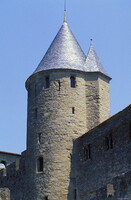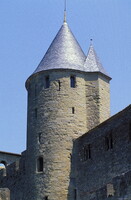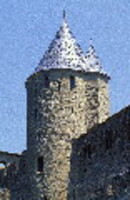| dc.coverage.spatial | Site: Carcassonne, Languedoc-Roussillon, France | en_US |
| dc.coverage.temporal | ca. 300-1287 (creation) | en_US |
| dc.creator | unknown (French) | en_US |
| dc.date | 300-1287 | en_US |
| dc.date.accessioned | 2013-05-10T19:39:49Z | |
| dc.date.available | 2013-05-10T19:39:49Z | |
| dc.date.issued | 300-1287 | en_US |
| dc.identifier | 216303 | en_US |
| dc.identifier.other | archrefid: 284 | en_US |
| dc.identifier.uri | http://hdl.handle.net/1721.3/123932 | |
| dc.description | Ramparts, general view of a turret; Medieval fortified town in Languedoc, southern France. Situated on a plateau dominating the plain of the Aude, the walled town of Carcassonne is roughly rectangular in shape, up to 525 m long and 250 m wide. It is still surrounded by its medieval double enclosure wall: the inner curtain is about 1245 m in length, with 29 towers, while the outer has 18 towers and is about 1320 m long. The Château Comtal and the former cathedral of St Nazaire are part of the town. The historian Viollet-le-Duc was responsible for it's restoration in the 19th century, between 1852 and 1879, adding crenellations to the walls and giving the towers slate roofs. The use of slates has been strongly criticized, however, and restorers are replacing them with clay ridge tiles. Source: Grove Art Online; http://www.groveart.com/ (accessed 1/10/2008) | en_US |
| dc.format.medium | stone; sandstone | en_US |
| dc.rights | © Scott Gilchrist, Archivision, Inc. | en_US |
| dc.subject | architectural exteriors | en_US |
| dc.subject | military | en_US |
| dc.subject | war | en_US |
| dc.subject | Medieval | en_US |
| dc.title | Carcassonne | en_US |
| dc.type | image | en_US |
| dc.rights.access | Licensed for educational and research use by the MIT community only | en_US |
| dc.identifier.vendorcode | 1A2-F-C-CO-E1 | en_US |
| vra.culturalContext | French | en_US |
| vra.technique | construction (assembling) | en_US |
| vra.worktype | fortification | en_US |
| vra.worktype | castle (fortification) | en_US |
| dc.contributor.display | unknown (French) | en_US |



